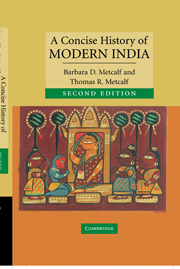Book contents
- Frontmatter
- Contents
- List of illustrations
- Preface to the second edition
- Preface to the first edition
- Glossary
- Chronology
- 1 Sultans, Mughals, and pre-colonial Indian society
- 2 Mughal twilight: the emergence of regional states and the East India Company
- 3 The East India Company Raj, 1772–1850
- 4 Revolt, the modern state, and colonized subjects, 1848–1885
- 5 Civil society, colonial constraints, 1885–1919
- 6 The crisis of the colonial order, 1919–1939
- 7 The 1940s: triumph and tragedy
- 8 Congress Raj: democracy and development, 1950–1989
- 9 Democratic India in the nineties: coalitions, class, community, consumers, and conflict
- Epilogue: a new century begins
- Biographical notes
- Bibliographic essay
- Index
- CAMBRIDGE CONCISE HISTORIES
9 - Democratic India in the nineties: coalitions, class, community, consumers, and conflict
Published online by Cambridge University Press: 05 June 2012
- Frontmatter
- Contents
- List of illustrations
- Preface to the second edition
- Preface to the first edition
- Glossary
- Chronology
- 1 Sultans, Mughals, and pre-colonial Indian society
- 2 Mughal twilight: the emergence of regional states and the East India Company
- 3 The East India Company Raj, 1772–1850
- 4 Revolt, the modern state, and colonized subjects, 1848–1885
- 5 Civil society, colonial constraints, 1885–1919
- 6 The crisis of the colonial order, 1919–1939
- 7 The 1940s: triumph and tragedy
- 8 Congress Raj: democracy and development, 1950–1989
- 9 Democratic India in the nineties: coalitions, class, community, consumers, and conflict
- Epilogue: a new century begins
- Biographical notes
- Bibliographic essay
- Index
- CAMBRIDGE CONCISE HISTORIES
Summary
We are a free and sovereign people today and we have rid ourselves of the burden of the past. We look at the world with clear and friendly eyes and at the future with faith and confidence.
Prime Minister Jawaharlal Nehru, broadcast from New Delhi, 15 August 1947The hopeful words of any nation's founding fathers are likely to be read with some degree of irony a half-century later. In India, half-centennial reflections on the past were occasioned not only by the country's anniversary but also by the end of the millennium, a focus for stocktaking everywhere. If the words of the founding fathers at times rang hollow, they also, in fact, predicted many successes, not least India's proud claim to be the world's largest democracy (plate 9.1). A baker's dozen of general elections, by century's end, and hundreds of state elections had produced a vastly enlarged and very lively political system. In the year of the golden anniversary, K. R. Narayanan (1920–2005), Dalit by birth, was sworn in as India's president, a powerful symbol of the progress and aspirations of ‘untouchables’. The role of president, importantly, one might note, had been assumed on two earlier occasions in the half-century by a Muslim and, most poignantly, at the time of Indira Gandhi's assassination, by a Sikh. The Supreme Court's activism, for example in indictments of top government and political leaders for bribery and corruption as well as in favouring public-interest litigation, had strengthened the effective exercise of civil liberties.
- Type
- Chapter
- Information
- A Concise History of Modern India , pp. 265 - 295Publisher: Cambridge University PressPrint publication year: 2006



